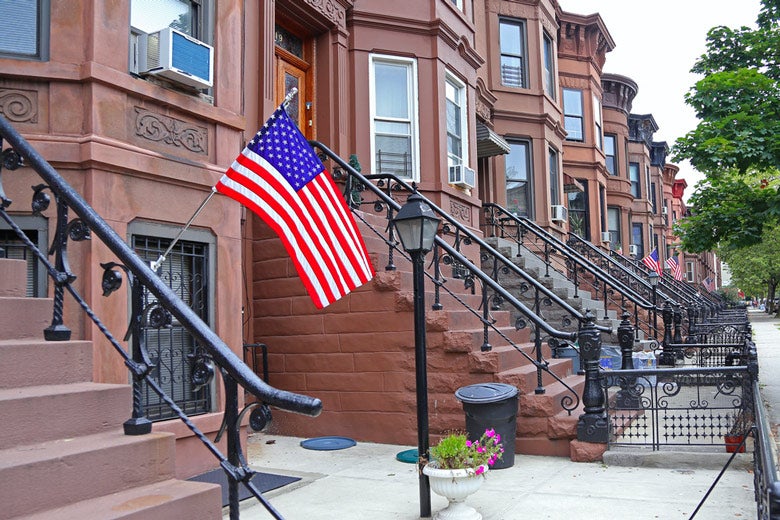
People who identify as either Democrat or Republican desire neighborhoods with people who share their political preferences when they are given that information, according to a new study.
Americans today appear more divided along partisan lines than ever, and this polarization extends to where they choose to live, a Stanford scholar has found.
People who identify as either Democrat or Republican desire neighborhoods with people who share their political preferences when they are given that information, according to a new study by Iris Hui, a Stanford postdoctoral fellow at the Bill Lane Center for the American West.
In an interview, Hui pointed out that the most important factors continue to be safety, amenities, schools and distance to workplaces. Political affiliation serves as a “tiebreaker” of sorts to the more primary reasons for neighborhood choice.
“Depending on the partisan composition, the desirability of a place can increase by 20 percent when respondents are informed the location has a sizeable presence of co-partisans,” Hui wrote.
She noted that about the same magnitude of decline (20 percent) in desirability occurs when respondents are told the opposite. And, respondents who report themselves as independents or unaffiliated with either the Democratic or Republican parties do not care as much about neighborhood partisanship, she added.
According to Hui, people make an average of about 12 residence moves across their lifespans. This matters, because when people begin to sort themselves into partisan places – even if partisanship is not a dominant reason – these relocations can exacerbate the lopsidedness of local electoral margins for one party and thereby increase legislative polarization.
Hui’s co-author was James Gimpel, a professor of government from the University of Maryland.
‘Perceptions of fit’
Hui and Gimpel conducted a national survey experiment of 1,506 adults. Participants were shown four photographs of distinct properties and given information about the neighborhood’s socioeconomic and partisan makeup. The idea was to explore how political information affected the way people evaluated the properties.
They found that while political considerations do not trump other concerns in the search for a place to reside, they do matter when all factors are considered. “Respondents who self-identify as either Democrats or Republicans are more likely to prefer properties situated in neighborhoods with a higher co-partisan concentration,” they wrote.
The study showed that the final neighborhood choice comes down to “perceptions of fit,” based on the appearance of neighborhood and housing and additional information inferred about the characteristics of residents, including political affiliations.
For instance, Hui said, a strong environmentalist may seek higher density housing with access to mass transit, closer to downtown workplaces, and neighbors who share similar transportation and housing preferences.
Hui offered one explanation for this dynamic: “Certainly the impulse to seek out socially supportive living environments is thought to be a function of the desire to avoid the unpleasantness of conflict and disagreement.”
She noted that in addition to the physical appearance of a property, people rely on racial composition information as a cue to infer the neighborhood political mix.
“Some respondents could also venture reasonable estimates of political composition just from knowing where the property was located relative to a city’s downtown. This experiment clearly suggests that citizens are able to form perceptions and draw inferences about the partisanship of places based on observable socioeconomic markers,” wrote Hui.
She said the research shows that Democrats cluster in urban areas and Republicans in rural areas based on attitudes and viewpoints as well as “pre-existing political balance that attracts an influx of co-partisans, while driving away others.”
Still, if a Democrat prefers living in a particular rural setting and he discovers he would be a political minority in that community, it would not necessarily cause him to relocate, according to the research. “Yet he would not necessarily pick a more urban location just to live among co-partisans,” she wrote.
Effect on legislatures
The findings present real-world implications beyond the neighborhoods themselves, Hui said. As she pointed out, “residential segregation by partisanship” has been increasing since the 1990s and has contributed to legislative polarization – a sort of “Red” vs. “Blue” effect at local, state and federal levels. (Red refers to Republican and Blue to Democrat.)
“Even if a small fraction of partisans make choices on a political basis, the cumulative effect in the long run can greatly augment population differences across space,” she said.
But the effect should not be overstated. People are not moving simply for political reasons primarily, she said. At any given time only a modest measure of residential sorting by party occurs. And even the allure of like-minded partisans does not compensate for limited job prospects or bad schools.
“After all, a suburb with a good school district and safe streets is a magnet for citizens of both parties,” she said.
Media Contacts
Iris Hui, Bill Lane Center for the American West: (650) 725-7526, irishui@stanford.edu
Clifton B. Parker, Stanford News Service: (650) 725-0224, cbparker@stanford.edu